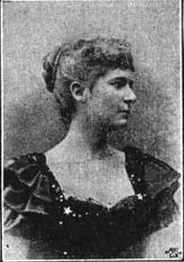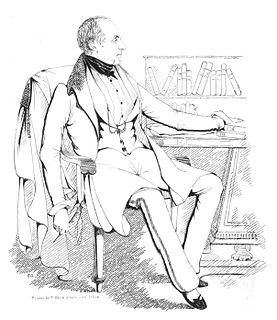Related Research Articles

William Harrison Ainsworth was an English historical novelist born at King Street in Manchester. He trained as a lawyer, but the legal profession held no attraction for him. While completing his legal studies in London he met the publisher John Ebers, at that time manager of the King's Theatre, Haymarket. Ebers introduced Ainsworth to literary and dramatic circles, and to his daughter, who became Ainsworth's wife.

John Abraham Heraud (1799–1887) was an English journalist and poet. He published two extravagant epic poems, The Descent into Hell (1830), and The Judgment of the Flood (1834). He also wrote plays, and travel books.

John Westland Marston was an English dramatist and critic.
Fraser's Magazine for Town and Country was a general and literary journal published in London from 1830 to 1882, which initially took a strong Tory line in politics. It was founded by Hugh Fraser and William Maginn in 1830 and loosely directed by Maginn under the name Oliver Yorke until about 1840. It circulated until 1882, when it was renamed Longman's Magazine.
Henry Colburn was a British publisher.
Nationality words link to articles with information on the nation's poetry or literature.
Peter George Patmore was an English author.

The British Critic: A New Review was a quarterly publication, established in 1793 as a conservative and high-church review journal riding the tide of British reaction against the French Revolution. The headquarters was in London. The journal ended publication in 1843.
Cyrus Redding (1785–1870) was a British journalist and wine writer.
John Debrett was an English publisher and compiler. His name has become associated with reference books.

Ella Hepworth Dixon was an English author and editor. Her best-known work is the New Woman novel The Story of a Modern Woman, which has been reprinted in the 21st century.

David Lester Richardson was an officer of the East India Company, who throughout his life followed literary pursuits as a poet and periodical writer, and as editor and proprietor of literary journals. A skilled linguist, he was in later life an educator, serving as professor of English at Hindu College, where he inspired the Bengali poet Michael Madhusudan Dutta.
Frederic Shoberl (1775–1853), also known as Frederick Schoberl, was an English journalist, editor, translator, writer and illustrator. Shoberl edited Forget-Me-Not, the first literary annual, issued at Christmas "for 1823" and translated The Hunchback of Notre Dame.

Richard Bentley was a 19th-century English publisher born into a publishing family. He started a firm with his brother in 1819. Ten years later, he went into partnership with the publisher Henry Colburn. Although the business was often successful, publishing the famous "Standard Novels" series, they ended their partnership in acrimony three years later. Bentley continued alone profitably in the 1830s and early 1840s, establishing the well-known periodical Bentley's Miscellany. However, the periodical went into decline after its editor, Charles Dickens, left. Bentley's business started to falter after 1843 and he sold many of his copyrights. Only 15 years later did it begin to recover.
Edward Howard was an English novelist and sub-editor of The Metropolitan Magazine. He then worked for New Monthly Magazine. His most successful books were Sir Henry Morgan and Rattlin the Reefer.

The Monthly Magazine (1796–1843) of London began publication in February 1796.
Emma Roberts (1794–1840), often referred to as "Miss Emma Roberts", was an English travel writer and poet known for her memoirs about India. In her own time, she was well regarded, and William Jerdan considered her "a very successful cultivator of the belles lettres".
William Francis Ainsworth was an English surgeon, traveller, geographer and geologist, known also as a writer and editor.
Francis Foster Barham was an English religious writer, known as the 'Alist'.
References
- ↑ David Higgins, 'The New Monthly Magazine', The Literary Encyclopedia, 22 October 2006.
- ↑ 'Introduction', Wellesley Index to Periodical Literature
- ↑ 'Introduction', Wellesley Index to Periodical Literature; Higgins, The Literary Encyclopedia.
- ↑ New Monthly Magazine Vol 3, 1822 page 102 at Google Books
- ↑ Higgins, The Literary Encyclopedia.
- ↑ Introduction, Wellesley Index to Victorian Periodicals
- 1 2 3 4 5 6 7 8 HathiTrust Digital Library provides full view of bound volumes through 1870, and some thereafter. See one catalogue record (recommended). Volume title pages name these editors:
- Theodore Hook, Esq (v. 49-62; 1837–41)
- Thomas Hood, Esq (v. 63-68; 1841–43)
- none (v. 69-72; 1843–44)
- William Harrison Ainsworth (v. 73-147; 1845–70), at least
- ↑ 'Introduction', Wellesley Index to Periodical Literature. According to the ODNB, the transcendentalist Francis Barham (1808–1871) edited the paper at around this time: "Two hundred pounds invested in the New Monthly Magazine procured him the joint editorship with John Abraham Heraud, the poet and dramatist. Anne Taylor, "Barham, Francis Foster (Alist Francis Barham) (1808–1871)", Oxford Dictionary of National Biography, Oxford University Press, 2004, accessed 4 January 2008. Heraud's ODNB entry has him editing the Monthly Magazine from 1839 to 1842, but does not mention the New Monthly.
- ↑ List of periodical titles , retrieved 10 June 2010 (Scroll down to see title listings for The New Monthly, listed below The New London Magazine and above The New Quarterly Magazine
- ↑ Banerji, Nilanjana. "Shoberl, Frederic". Oxford Dictionary of National Biography (online ed.). Oxford University Press. doi:10.1093/ref:odnb/25450.(Subscription or UK public library membership required.)
- ↑ "Samuel Carter Hall". www.ricorso.net.
- ↑ 1839–1840 Francis Foster Barham edited with John Abraham Heraud, according to Thompson Cooper's DNB article on Barham; contradicted by the ODNB biography of Heraud which says it was the Monthly Magazine 1839–1842, though supported by the ODNB biography of Barham.